Free
gold!
Article
by Dave Antonucci.
Free gold started the gold rush of 1849
and it's free gold that I search for now. Free gold….
sounds nice doesn’t it?
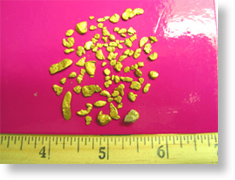 While
it is not exactly free it really is the only valuable mineral
you can literally just pick up off the ground in some abundance
although in my case the “ground” is a solid slab
of bedrock under water. Free gold is a relatively pure specimen
of gold that has been liberated from its host ore. In the Sierra
Nevadas, where I do all of my mining, the vast majority of free
gold was once held by white quartz, a fairly common and beautiful
host rock.
While
it is not exactly free it really is the only valuable mineral
you can literally just pick up off the ground in some abundance
although in my case the “ground” is a solid slab
of bedrock under water. Free gold is a relatively pure specimen
of gold that has been liberated from its host ore. In the Sierra
Nevadas, where I do all of my mining, the vast majority of free
gold was once held by white quartz, a fairly common and beautiful
host rock.
The 49’ers (48’ers really) were a rag tag bunch
of treasure seekers in search of an adventure. For the most
part, they had no mining skills, no real knowledge of geology
but they did have a healthy dose of gumption (ignorance?). The
only gold those “pie in the sky” Argonauts could
or would be able find would be that which was easily processed
from the local gravels lying in or near streambeds. Gold is
the single heaviest naturally occurring element, which gives
it the ability to be sorted or classified within its locally
occurring companion materials. In other words: it sinks. It
sinks in water, it sinks in gravel or sand or dirt or…you
get the idea. The gold rush miners learned rather quickly that
to find gold you had to dig down to a layer of material that
was solid.
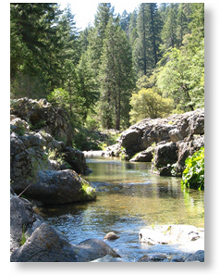 This solid layer would become the resting-place of the nuggets
until the next flood or landslide moved it on to another solid
resting-place. These resting-places could be open cracks in
slabs of rock or maybe a crevice in the solid bedrock at the
bottom of a stream bed. Back then they would have to work the
exposed bedrock that was high and dry which really limited the
amount of mineable land one claim had on it. However, as the
summer wore on and the water level dropped they would work further
towards the flowing river channels. Some of the more enterprising
miners learned that through a team effort they could build a
dam and force the water up on the bank and around the claim,
thus giving them access to the really rich pay streaks that
often lie down the center of a river channel. It required one
heck of a lot of work to risk whether or not your piece of channel
held any gold or not. The life of a 49’er was not an easy
one nor lucrative for most. The lack of mining skills really
kept them from taking advantage of huge deposits that were just
a few feet away - not that they didn’t find huge deposits.
They were just limited on which ones they could access.
This solid layer would become the resting-place of the nuggets
until the next flood or landslide moved it on to another solid
resting-place. These resting-places could be open cracks in
slabs of rock or maybe a crevice in the solid bedrock at the
bottom of a stream bed. Back then they would have to work the
exposed bedrock that was high and dry which really limited the
amount of mineable land one claim had on it. However, as the
summer wore on and the water level dropped they would work further
towards the flowing river channels. Some of the more enterprising
miners learned that through a team effort they could build a
dam and force the water up on the bank and around the claim,
thus giving them access to the really rich pay streaks that
often lie down the center of a river channel. It required one
heck of a lot of work to risk whether or not your piece of channel
held any gold or not. The life of a 49’er was not an easy
one nor lucrative for most. The lack of mining skills really
kept them from taking advantage of huge deposits that were just
a few feet away - not that they didn’t find huge deposits.
They were just limited on which ones they could access.
Well, that is where I come in.
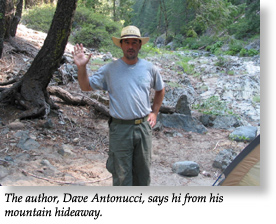 Some
things have not changed one bit since 1849. The poison ivy still
itches, the mosquitoes still bite, the rocks are still so very
heavy, and gold fever still rages amongst a few modern miners
with stars in their eyes. I got the fever about 17 years ago.
Got it bad. I took a history class on the gold rush at the local
JC. We went on a field trip into the mother load that included
a panning demonstration and guess what? I found gold! It was
one tiny spec but heck it was gold and there it was twinkling
brightly at the bottom of my brand new gold pan! My girlfriend
and I started taking all of our camping trips in the gold country
and with my new 4-wheel drive pick up we just about bounced
around every corner of the Sierra - prospecting here, camping
there and doing a quite a bit of ghost town hunting right along.
Some
things have not changed one bit since 1849. The poison ivy still
itches, the mosquitoes still bite, the rocks are still so very
heavy, and gold fever still rages amongst a few modern miners
with stars in their eyes. I got the fever about 17 years ago.
Got it bad. I took a history class on the gold rush at the local
JC. We went on a field trip into the mother load that included
a panning demonstration and guess what? I found gold! It was
one tiny spec but heck it was gold and there it was twinkling
brightly at the bottom of my brand new gold pan! My girlfriend
and I started taking all of our camping trips in the gold country
and with my new 4-wheel drive pick up we just about bounced
around every corner of the Sierra - prospecting here, camping
there and doing a quite a bit of ghost town hunting right along.
Fast forward 14 years….my mining partner and I have a
900 foot long claim on a super rich, super remote, piece of
creek way up in the Sierra. Over the years, we have worked our
way up to a $7000 “6 inch” super dredge. Crack Attack
we call her. That’s a far cry from my first gold pan or
even our first 4” dredge (dredges are measured by their
intake hose diameter). Shoot, that old little dredge I used
to pack in by myself and dredge wherever I wanted! (On unclaimed
open water of course). But our little slice of heaven is the
best! Crystal clear water, wild trout, and shiny gold nuggets!
You know those deep channels the 49’ers avoided? Well
that is where we set up shop. With a dredge, you are required
to mine in the water, just the opposite of what the 49’ers
were attempting to do. We also have science on our side. When
you apply the science of hydrology and mineralogy together you
are preparing yourself to “read” a stretch of water.
The laws were the same back then. They just didn’t know
what to look for. You know the old timers figured it out by
trial and error and guarded these “secrets” well.
Most of the gold rush boys gave up after one or two years best
and never figured it out. They just moved from strike to strike
hoping for the best. It was the old-timers who unlocked the
secrets of modern prospecting. Today you can just pick up a
good mining book and most of the “secrets” are explained
thoroughly. Even so, I know of one miner/author who was getting
chewed out by some professional miners for writing about these
“secrets” even today.
Free gold….that’s what I’m after and that’s
what we mine.
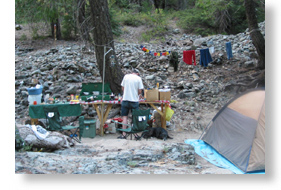 For
me part of the allure for this somewhat odd activity has been
a desire to experience something of our country's rich history
firsthand. I have always been fascinated with our country's
history and my outdoor interests just supported my increasing
desire to experience just about anything to do with the gold
rush. And why not? It just so happens that the gold country
is my backyard. So over the years my partner and I have come
to relish the isolation and brutal back breaking labor that
is the nature of placer mining. We began to believe we were
reliving the past, that we were actually tasting a rare slice
of important history. How many historians actually live the
life of the era they have devoted their life into understanding?
You may say "well, there are many living history museums
in the U.S." but really now, are they a realistic display
or are those participants actively pursuing the activity because
they wish to achieve the same thing the historical figures did?
No, we believed we were living the experience in fashion much
closer to the heart.
For
me part of the allure for this somewhat odd activity has been
a desire to experience something of our country's rich history
firsthand. I have always been fascinated with our country's
history and my outdoor interests just supported my increasing
desire to experience just about anything to do with the gold
rush. And why not? It just so happens that the gold country
is my backyard. So over the years my partner and I have come
to relish the isolation and brutal back breaking labor that
is the nature of placer mining. We began to believe we were
reliving the past, that we were actually tasting a rare slice
of important history. How many historians actually live the
life of the era they have devoted their life into understanding?
You may say "well, there are many living history museums
in the U.S." but really now, are they a realistic display
or are those participants actively pursuing the activity because
they wish to achieve the same thing the historical figures did?
No, we believed we were living the experience in fashion much
closer to the heart.
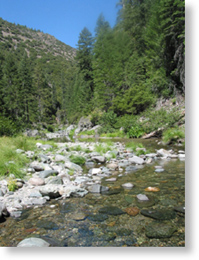 I
have recently come to realize, deep in those steep mountains,
that many things are not the same as they were when the land
was overrun with thousands of hopeful prospectors 154 years
ago. Our little stream is actually much cleaner than it would
have been in 1849. Our steep canyon is one heck of lot quieter
than it was in 1849. I came across an excerpt from William Swains'
journal (a 49'er) that described a sort of frenzy on those mountain
side cow paths as would-be miners scoured and moved along at
an alarming rate. These sturdy young men were always looking
for greener pastures. There was a constant migration of humans
from one creek to another, always looking for the "big
strike". Our camp on our little creek would have had a
constant flow of men walking through it. There would have been
a claim with miners working them every 100 feet or so. This
is extremely hard to imagine considering how difficult the terrain
is. Oh we have it much better now. It's actually the escape
from humanity we all day dream about. Back then you would have
to leave the mountains to find solitude. So now, I tell myself
that our mine is just as if it would have been at around 1880.
By then most of the placer mining was over with. The few 49'ers
who stayed were now the "old timers" we all saw pictures
of in our textbooks. You know, the grizzled miner bent over
a gold pan creek-side. Of course, we have to ignore our nice
and light Honda engines or the 300 lbs. of Coleman camping equipment
back at camp. But really, at days' end when the engines are
shut down and we are panning out about 75 lbs. of concentrates
that contain all the gold, your soul tells you that you are
not unique in what you are doing on this exact spot. Sitting
on that exact rock in the middle of that icy stream.
I
have recently come to realize, deep in those steep mountains,
that many things are not the same as they were when the land
was overrun with thousands of hopeful prospectors 154 years
ago. Our little stream is actually much cleaner than it would
have been in 1849. Our steep canyon is one heck of lot quieter
than it was in 1849. I came across an excerpt from William Swains'
journal (a 49'er) that described a sort of frenzy on those mountain
side cow paths as would-be miners scoured and moved along at
an alarming rate. These sturdy young men were always looking
for greener pastures. There was a constant migration of humans
from one creek to another, always looking for the "big
strike". Our camp on our little creek would have had a
constant flow of men walking through it. There would have been
a claim with miners working them every 100 feet or so. This
is extremely hard to imagine considering how difficult the terrain
is. Oh we have it much better now. It's actually the escape
from humanity we all day dream about. Back then you would have
to leave the mountains to find solitude. So now, I tell myself
that our mine is just as if it would have been at around 1880.
By then most of the placer mining was over with. The few 49'ers
who stayed were now the "old timers" we all saw pictures
of in our textbooks. You know, the grizzled miner bent over
a gold pan creek-side. Of course, we have to ignore our nice
and light Honda engines or the 300 lbs. of Coleman camping equipment
back at camp. But really, at days' end when the engines are
shut down and we are panning out about 75 lbs. of concentrates
that contain all the gold, your soul tells you that you are
not unique in what you are doing on this exact spot. Sitting
on that exact rock in the middle of that icy stream.
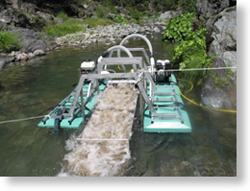 There
is an innate kindrence with some localized spirit that still
haunts this spot. Inside your head, if you listen carefully
you can almost hear the rhythmic clink of a shovel on some chunk
of river rock. It's not spooky; it's just kind of "thick"
in the air. You know they were there. All you have to do is
look up on the steep bank to still see their many piles of hand
stacked rocks. Even though the old mines are heavily overgrown
now you can still plainly see the evidence of hand labor everywhere.
We always mine where they mined heavily. Where they found gold,
we find gold also. Maybe that is the buzz in the air. We are
working a piece of creek that was some long gone team's bonanza
way back when. Something in my head tells me they did well here.
I wonder what their names were. I take a quick look around in
the fading post sunset light and then concentrate on my half
full gold pan. I look for my plastic sucker bottle but have
to unscrew the lid because the picker in my pan is too big to
fit in the narrow opening. That's worth a smile because I still
have two and a half pans to go. It's gonna be a good evening
in the mines! Warm beer anyone?
There
is an innate kindrence with some localized spirit that still
haunts this spot. Inside your head, if you listen carefully
you can almost hear the rhythmic clink of a shovel on some chunk
of river rock. It's not spooky; it's just kind of "thick"
in the air. You know they were there. All you have to do is
look up on the steep bank to still see their many piles of hand
stacked rocks. Even though the old mines are heavily overgrown
now you can still plainly see the evidence of hand labor everywhere.
We always mine where they mined heavily. Where they found gold,
we find gold also. Maybe that is the buzz in the air. We are
working a piece of creek that was some long gone team's bonanza
way back when. Something in my head tells me they did well here.
I wonder what their names were. I take a quick look around in
the fading post sunset light and then concentrate on my half
full gold pan. I look for my plastic sucker bottle but have
to unscrew the lid because the picker in my pan is too big to
fit in the narrow opening. That's worth a smile because I still
have two and a half pans to go. It's gonna be a good evening
in the mines! Warm beer anyone?

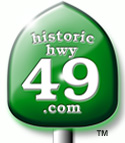

 While
it is not exactly free it really is the only valuable mineral
you can literally just pick up off the ground in some abundance
although in my case the “ground” is a solid slab
of bedrock under water. Free gold is a relatively pure specimen
of gold that has been liberated from its host ore. In the Sierra
Nevadas, where I do all of my mining, the vast majority of free
gold was once held by white quartz, a fairly common and beautiful
host rock.
While
it is not exactly free it really is the only valuable mineral
you can literally just pick up off the ground in some abundance
although in my case the “ground” is a solid slab
of bedrock under water. Free gold is a relatively pure specimen
of gold that has been liberated from its host ore. In the Sierra
Nevadas, where I do all of my mining, the vast majority of free
gold was once held by white quartz, a fairly common and beautiful
host rock. This solid layer would become the resting-place of the nuggets
until the next flood or landslide moved it on to another solid
resting-place. These resting-places could be open cracks in
slabs of rock or maybe a crevice in the solid bedrock at the
bottom of a stream bed. Back then they would have to work the
exposed bedrock that was high and dry which really limited the
amount of mineable land one claim had on it. However, as the
summer wore on and the water level dropped they would work further
towards the flowing river channels. Some of the more enterprising
miners learned that through a team effort they could build a
dam and force the water up on the bank and around the claim,
thus giving them access to the really rich pay streaks that
often lie down the center of a river channel. It required one
heck of a lot of work to risk whether or not your piece of channel
held any gold or not. The life of a 49’er was not an easy
one nor lucrative for most. The lack of mining skills really
kept them from taking advantage of huge deposits that were just
a few feet away - not that they didn’t find huge deposits.
They were just limited on which ones they could access.
This solid layer would become the resting-place of the nuggets
until the next flood or landslide moved it on to another solid
resting-place. These resting-places could be open cracks in
slabs of rock or maybe a crevice in the solid bedrock at the
bottom of a stream bed. Back then they would have to work the
exposed bedrock that was high and dry which really limited the
amount of mineable land one claim had on it. However, as the
summer wore on and the water level dropped they would work further
towards the flowing river channels. Some of the more enterprising
miners learned that through a team effort they could build a
dam and force the water up on the bank and around the claim,
thus giving them access to the really rich pay streaks that
often lie down the center of a river channel. It required one
heck of a lot of work to risk whether or not your piece of channel
held any gold or not. The life of a 49’er was not an easy
one nor lucrative for most. The lack of mining skills really
kept them from taking advantage of huge deposits that were just
a few feet away - not that they didn’t find huge deposits.
They were just limited on which ones they could access. Some
things have not changed one bit since 1849. The poison ivy still
itches, the mosquitoes still bite, the rocks are still so very
heavy, and gold fever still rages amongst a few modern miners
with stars in their eyes. I got the fever about 17 years ago.
Got it bad. I took a history class on the gold rush at the local
JC. We went on a field trip into the mother load that included
a panning demonstration and guess what? I found gold! It was
one tiny spec but heck it was gold and there it was twinkling
brightly at the bottom of my brand new gold pan! My girlfriend
and I started taking all of our camping trips in the gold country
and with my new 4-wheel drive pick up we just about bounced
around every corner of the Sierra - prospecting here, camping
there and doing a quite a bit of ghost town hunting right along.
Some
things have not changed one bit since 1849. The poison ivy still
itches, the mosquitoes still bite, the rocks are still so very
heavy, and gold fever still rages amongst a few modern miners
with stars in their eyes. I got the fever about 17 years ago.
Got it bad. I took a history class on the gold rush at the local
JC. We went on a field trip into the mother load that included
a panning demonstration and guess what? I found gold! It was
one tiny spec but heck it was gold and there it was twinkling
brightly at the bottom of my brand new gold pan! My girlfriend
and I started taking all of our camping trips in the gold country
and with my new 4-wheel drive pick up we just about bounced
around every corner of the Sierra - prospecting here, camping
there and doing a quite a bit of ghost town hunting right along.
 For
me part of the allure for this somewhat odd activity has been
a desire to experience something of our country's rich history
firsthand. I have always been fascinated with our country's
history and my outdoor interests just supported my increasing
desire to experience just about anything to do with the gold
rush. And why not? It just so happens that the gold country
is my backyard. So over the years my partner and I have come
to relish the isolation and brutal back breaking labor that
is the nature of placer mining. We began to believe we were
reliving the past, that we were actually tasting a rare slice
of important history. How many historians actually live the
life of the era they have devoted their life into understanding?
You may say "well, there are many living history museums
in the U.S." but really now, are they a realistic display
or are those participants actively pursuing the activity because
they wish to achieve the same thing the historical figures did?
No, we believed we were living the experience in fashion much
closer to the heart.
For
me part of the allure for this somewhat odd activity has been
a desire to experience something of our country's rich history
firsthand. I have always been fascinated with our country's
history and my outdoor interests just supported my increasing
desire to experience just about anything to do with the gold
rush. And why not? It just so happens that the gold country
is my backyard. So over the years my partner and I have come
to relish the isolation and brutal back breaking labor that
is the nature of placer mining. We began to believe we were
reliving the past, that we were actually tasting a rare slice
of important history. How many historians actually live the
life of the era they have devoted their life into understanding?
You may say "well, there are many living history museums
in the U.S." but really now, are they a realistic display
or are those participants actively pursuing the activity because
they wish to achieve the same thing the historical figures did?
No, we believed we were living the experience in fashion much
closer to the heart.  I
have recently come to realize, deep in those steep mountains,
that many things are not the same as they were when the land
was overrun with thousands of hopeful prospectors 154 years
ago. Our little stream is actually much cleaner than it would
have been in 1849. Our steep canyon is one heck of lot quieter
than it was in 1849. I came across an excerpt from William Swains'
journal (a 49'er) that described a sort of frenzy on those mountain
side cow paths as would-be miners scoured and moved along at
an alarming rate. These sturdy young men were always looking
for greener pastures. There was a constant migration of humans
from one creek to another, always looking for the "big
strike". Our camp on our little creek would have had a
constant flow of men walking through it. There would have been
a claim with miners working them every 100 feet or so. This
is extremely hard to imagine considering how difficult the terrain
is. Oh we have it much better now. It's actually the escape
from humanity we all day dream about. Back then you would have
to leave the mountains to find solitude. So now, I tell myself
that our mine is just as if it would have been at around 1880.
By then most of the placer mining was over with. The few 49'ers
who stayed were now the "old timers" we all saw pictures
of in our textbooks. You know, the grizzled miner bent over
a gold pan creek-side. Of course, we have to ignore our nice
and light Honda engines or the 300 lbs. of Coleman camping equipment
back at camp. But really, at days' end when the engines are
shut down and we are panning out about 75 lbs. of concentrates
that contain all the gold, your soul tells you that you are
not unique in what you are doing on this exact spot. Sitting
on that exact rock in the middle of that icy stream.
I
have recently come to realize, deep in those steep mountains,
that many things are not the same as they were when the land
was overrun with thousands of hopeful prospectors 154 years
ago. Our little stream is actually much cleaner than it would
have been in 1849. Our steep canyon is one heck of lot quieter
than it was in 1849. I came across an excerpt from William Swains'
journal (a 49'er) that described a sort of frenzy on those mountain
side cow paths as would-be miners scoured and moved along at
an alarming rate. These sturdy young men were always looking
for greener pastures. There was a constant migration of humans
from one creek to another, always looking for the "big
strike". Our camp on our little creek would have had a
constant flow of men walking through it. There would have been
a claim with miners working them every 100 feet or so. This
is extremely hard to imagine considering how difficult the terrain
is. Oh we have it much better now. It's actually the escape
from humanity we all day dream about. Back then you would have
to leave the mountains to find solitude. So now, I tell myself
that our mine is just as if it would have been at around 1880.
By then most of the placer mining was over with. The few 49'ers
who stayed were now the "old timers" we all saw pictures
of in our textbooks. You know, the grizzled miner bent over
a gold pan creek-side. Of course, we have to ignore our nice
and light Honda engines or the 300 lbs. of Coleman camping equipment
back at camp. But really, at days' end when the engines are
shut down and we are panning out about 75 lbs. of concentrates
that contain all the gold, your soul tells you that you are
not unique in what you are doing on this exact spot. Sitting
on that exact rock in the middle of that icy stream. There
is an innate kindrence with some localized spirit that still
haunts this spot. Inside your head, if you listen carefully
you can almost hear the rhythmic clink of a shovel on some chunk
of river rock. It's not spooky; it's just kind of "thick"
in the air. You know they were there. All you have to do is
look up on the steep bank to still see their many piles of hand
stacked rocks. Even though the old mines are heavily overgrown
now you can still plainly see the evidence of hand labor everywhere.
We always mine where they mined heavily. Where they found gold,
we find gold also. Maybe that is the buzz in the air. We are
working a piece of creek that was some long gone team's bonanza
way back when. Something in my head tells me they did well here.
I wonder what their names were. I take a quick look around in
the fading post sunset light and then concentrate on my half
full gold pan. I look for my plastic sucker bottle but have
to unscrew the lid because the picker in my pan is too big to
fit in the narrow opening. That's worth a smile because I still
have two and a half pans to go. It's gonna be a good evening
in the mines! Warm beer anyone?
There
is an innate kindrence with some localized spirit that still
haunts this spot. Inside your head, if you listen carefully
you can almost hear the rhythmic clink of a shovel on some chunk
of river rock. It's not spooky; it's just kind of "thick"
in the air. You know they were there. All you have to do is
look up on the steep bank to still see their many piles of hand
stacked rocks. Even though the old mines are heavily overgrown
now you can still plainly see the evidence of hand labor everywhere.
We always mine where they mined heavily. Where they found gold,
we find gold also. Maybe that is the buzz in the air. We are
working a piece of creek that was some long gone team's bonanza
way back when. Something in my head tells me they did well here.
I wonder what their names were. I take a quick look around in
the fading post sunset light and then concentrate on my half
full gold pan. I look for my plastic sucker bottle but have
to unscrew the lid because the picker in my pan is too big to
fit in the narrow opening. That's worth a smile because I still
have two and a half pans to go. It's gonna be a good evening
in the mines! Warm beer anyone?